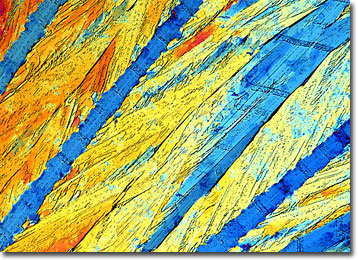Polarized Light Microscopy Digital Image Gallery
Adipic Acid
Adipic acid is a dicarboxylic acid that is derived from the oxidation of certain fats. The name of the substance, which is chiefly utilized in the production of nylon, reflects its origin, stemming from the Latin word adeps or adip, both of which mean “fat.”

The type of nylon that adipic acid is utilized to fabricate is nylon 6,6, which is designated as such due to the presence of six carbon atoms in each of its two monomers. Wallace Hume Carothers of the DuPont Chemical Company first synthesized the polyamide in 1935 through a condensation reaction of adipic acid and 1,6-hexamethylenediamine, and its production could not have occurred at a better time. Fiber made from the newly invented nylon was introduced just in time to help replace silk, which became quite rare during the period because supplies from imperial Japan had been discontinued. Though extremely popular as stockings, nylon was also important for the United States military, which utilized the strong, elastic, mildew-resistant material for a wide array of applications during World War II.
Adipic acid commonly appears as a white crystalline powder that melts at 152 degrees Celsius. In addition to nylon production, the substance is utilized in the manufacture of a wide assortment of other products, such as plasticizers, wire coatings, foams, adhesives, and lubricants. Adipic acid is sometimes used in the food industry as well, especially as an ingredient in gelatins that facilitates quick setting and the maintenance of quality. Food grade adipic acid may also be found in puddings, condiments, gravies, snack foods, and a variety of other edible items.
